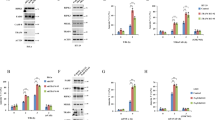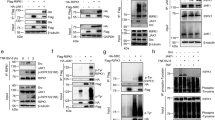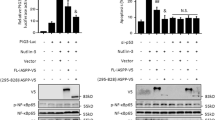Abstract
Double-stranded RNA-dependent protein kinase (PKR), a ubiquitously expressed serine/threonine kinase, has been implicated in the regulation or modulation of cell growth through multiple signaling pathways, but how PKR regulates tumor necrosis factor (TNF)-induced signaling pathways is poorly understood. In the present study, we used fibroblasts derived from PKR gene-deleted mice to investigate the role of PKR in TNF-induced activation of nuclear factor-κB (NF-κB), mitogen-activated protein kinases (MAPKs) and growth modulation. We found that in wild-type mouse embryonic fibroblast (MEF), TNF induced NF-κB activation as measured by DNA binding but deletion of PKR abolished this activation. This inhibition was associated with suppression of inhibitory subunit of NF-κB (IκB)α kinase (IKK) activation, IκBα phosphorylation and degradation, p65 phosphorylation and nuclear translocation, and NF-κB-dependent reporter gene transcription. TNF-induced Akt activation needed for IKK activation was also abolished by deletion of PKR. NF-κB activation was diminished in PKR-deleted cells transfected with TNF receptor (TNFR) 1, TNFR-associated death domain and TRAF2 plasmids; NF-κB activated by NF-κB-inducing kinase, IKK or p65, however, was minimally affected. Among the MAPKs, it was interesting that whereas TNF-induced c-Jun N-terminal kinase (JNK) activation was abolished, activation of p44/p42 MAPK and p38 MAPK was potentiated in PKR-deleted cells. TNF induced the expression of NF-κB-regulated gene products cyclin D1, c-Myc, matrix metalloproteinase-9, survivin, X-linked inhibitor-of-apoptosis protein (IAP), IAP1, Bcl-xL, A1/Bfl-1 and Fas-associated death domain protein-like IL-1β-converting enzyme-inhibitory protein in wild-type MEF but not in PKR−/− cells. Similarly, TNF induced the proliferation of wild-type cells, but this proliferation was completely suppressed in PKR-deleted cells. Overall, our results indicate that PKR differentially regulates TNF signaling; IKK, Akt and JNK were positively regulated, whereas p44/p42 MAPK and p38 MAPK were negatively regulated.
This is a preview of subscription content, access via your institution
Access options
Subscribe to this journal
Receive 50 print issues and online access
$259.00 per year
only $5.18 per issue
Buy this article
- Purchase on Springer Link
- Instant access to full article PDF
Prices may be subject to local taxes which are calculated during checkout






Similar content being viewed by others
Abbreviations
- dsRNA:
-
double-stranded RNA
- PKR:
-
dsRNA-dependent protein kinase
- NF-κB:
-
nuclear factor-κB
- IκB:
-
inhibitory subunit of NF-κB
- IKK:
-
IκBα kinase
- SEAP:
-
secretory alkaline phosphatase
- IAP:
-
inhibitor-of-apoptosis protein
- IL:
-
interleukin
- FADD:
-
Fas-associated death domain protein
- FLICE:
-
FADD-like IL-1β-converting enzyme
- FLIP:
-
FLICE-inhibitory protein
- MMP:
-
matrix metalloproteinase
- LPS:
-
lipopolysaccharide
- JNK:
-
c-Jun N-terminal kinase
- MAPK:
-
mitogen-activated protein kinase
References
Aggarwal BB . (2003). Signalling pathways of the TNF superfamily: a double-edged sword. Nat Rev Immunol 3: 745–756.
Aggarwal BB . (2004). Nuclear factor-kappaB: the enemy within. Cancer Cell 6: 203–208.
Balachandran S, Kim CN, Yeh WC, Mak TW, Bhalla K, Barber GN . (1998). Activation of the dsRNA-dependent protein kinase, PKR, induces apoptosis through FADD-mediated death signaling. EMBO J 17: 6888–6902.
Bandyopadhyay SK, de La Motte CA, Williams BR . (2000). Induction of E-selectin expression by double-stranded RNA and TNF-alpha is attenuated in murine aortic endothelial cells derived from double-stranded RNA-activated kinase (PKR)-null mice. J Immunol 164: 2077–2083.
Bonnet MC, Weil R, Dam E, Hovanessian AG, Meurs EF . (2000). PKR stimulates NF-kappaB irrespective of its kinase function by interacting with the IkappaB kinase complex. Mol Cell Biol 20: 4532–4542.
Carroll K, Elroy-Stein O, Moss B, Jagus R . (1993). Recombinant vaccinia virus K3L gene product prevents activation of double-stranded RNA-dependent, initiation factor 2 alpha-specific protein kinase. J Biol Chem 268: 12837–12842.
Chaturvedi MM, LaPushin R, Aggarwal BB . (1994). Tumor necrosis factor and lymphotoxin. Qualitative and quantitative differences in the mediation of early and late cellular response. J Biol Chem 269: 14575–14583.
Cheshire JL, Williams BR, Baldwin Jr AS . (1999). Involvement of double-stranded RNA-activated protein kinase in the synergistic activation of nuclear factor-kappaB by tumor necrosis factor-alpha and gamma-interferon in preneuronal cells. J Biol Chem 274: 4801–4806.
Cuddihy AR, Li S, Tam NW, Wong AH, Taya Y, Abraham N et al. (1999). Double-stranded-RNA-activated protein kinase PKR enhances transcriptional activation by tumor suppressor p53. Mol Cell Biol 19: 2475–2484.
Deb A, Haque SJ, Mogensen T, Silverman RH, Williams BR . (2001). RNA-dependent protein kinase PKR is required for activation of NF-kappa B by IFN-gamma in a STAT1-independent pathway. J Immunol 166: 6170–6180.
Demarchi F, Gutierrez MI, Giacca M . (1999). Human immunodeficiency virus type 1 tat protein activates transcription factor NF-kappaB through the cellular interferon-inducible, double-stranded RNA-dependent protein kinase, PKR. J Virol 73: 7080–7086.
Der SD, Yang YL, Weissmann C, Williams BR . (1997). A double-stranded RNA-activated protein kinase-dependent pathway mediating stress-induced apoptosis. Proc Natl Acad Sci USA 94: 3279–3283.
Donze O, Deng J, Curran J, Sladek R, Picard D, Sonenberg N . (2004). The protein kinase PKR: a molecular clock that sequentially activates survival and death programs. EMBO J 23: 564–571.
Esteve PO, Chicoine E, Robledo O, Aoudjit F, Descoteaux A, Potworowski EF et al. (2002). Protein kinase C-zeta regulates transcription of the matrix metalloproteinase-9 gene induced by IL-1 and TNF-alpha in glioma cells via NF-kappa B. J Biol Chem 277: 35150–35155.
Ghosh S, Karin M . (2002). Missing pieces in the NF-kappaB puzzle. Cell 109 (Suppl): S81–S96.
Ghosh S, May MJ, Kopp EB . (1998). NF-kappa B and Rel proteins: evolutionarily conserved mediators of immune responses. Annu Rev Immunol 16: 225–260.
Gil J, Alcami J, Esteban M . (2000). Activation of NF-kappa B by the dsRNA-dependent protein kinase, PKR involves the I kappa B kinase complex. Oncogene 19: 1369–1378.
Gil J, Garcia MA, Gomez-Puertas P, Guerra S, Rullas J, Nakano H et al. (2004). TRAF family proteins link PKR with NF-kappa B activation. Mol Cell Biol 24: 4502–4512.
Gil J, Rullas J, Garcia MA, Alcami J, Esteban M . (2001). The catalytic activity of dsRNA-dependent protein kinase, PKR, is required for NF-kappaB activation. Oncogene 20: 385–394.
Gilbert SJ, Duance VC, Mason DJ . (2004). Does protein kinase R mediate TNF-alpha- and ceramide-induced increases in expression and activation of matrix metalloproteinases in articular cartilage by a novel mechanism? Arthritis Res Ther 6: R46–R55.
Goh KC, deVeer MJ, Williams BR . (2000). The protein kinase PKR is required for p38 MAPK activation and the innate immune response to bacterial endotoxin. EMBO J 19: 4292–4297.
Grumont RJ, Rourke IJ, Gerondakis S . (1999). Rel-dependent induction of A1 transcription is required to protect B cells from antigen receptor ligation-induced apoptosis. Genes Dev 13: 400–411.
Gusella GL, Musso T, Rottschafer SE, Pulkki K, Varesio L . (1995). Potential requirement of a functional double-stranded RNA-dependent protein kinase (PKR) for the tumoricidal activation of macrophages by lipopolysaccharide or IFN-alpha beta, but not IFN-gamma. J Immunol 154: 345–354.
Guttridge DC, Albanese C, Reuther JY, Pestell RG, Baldwin Jr AS . (1999). NF-kappaB controls cell growth and differentiation through transcriptional regulation of cyclin D1. Mol Cell Biol 19: 5785–5799.
Hsu H, Shu HB, Pan MG, Goeddel DV . (1996). TRADD-TRAF2 and TRADD-FADD interactions define two distinct TNF receptor 1 signal transduction pathways. Cell 84: 299–308.
Iordanov MS, Paranjape JM, Zhou A, Wong J, Williams BR, Meurs EF et al. (2000). Activation of p38 mitogen-activated protein kinase and c-Jun NH(2)-terminal kinase by double-stranded RNA and encephalomyocarditis virus: involvement of RNase L, protein kinase R, and alternative pathways. Mol Cell Biol 20: 617–627.
Ishii T, Kwon H, Hiscott J, Mosialos G, Koromilas AE . (2001). Activation of the I kappa B alpha kinase (IKK) complex by double-stranded RNA-binding defective and catalytic inactive mutants of the interferon-inducible protein kinase PKR. Oncogene 20: 1900–1912.
Ito T, Jagus R, May WS . (1994). Interleukin 3 stimulates protein synthesis by regulating double-stranded RNA-dependent protein kinase. Proc Natl Acad Sci USA 91: 7455–7459.
Ito T, Yang M, May WS . (1999). RAX, a cellular activator for double-stranded RNA-dependent protein kinase during stress signaling. J Biol Chem 274: 15427–15432.
Jiang Z, Zamanian-Daryoush M, Nie H, Silva AM, Williams BR, Li X . (2003). Poly(I-C)-induced Toll-like receptor 3 (TLR3)-mediated activation of NFkappa B and MAP kinase is through an interleukin-1 receptor-associated kinase (IRAK)-independent pathway employing the signaling components TLR3-TRAF6-TAK1-TAB2-PKR. J Biol Chem 278: 16713–16719.
Kreuz S, Siegmund D, Scheurich P, Wajant H . (2001). NF-kappaB inducers upregulate cFLIP, a cycloheximide-sensitive inhibitor of death receptor signaling. Mol Cell Biol 21: 3964–3973.
Kronfeld-Kinar Y, Vilchik S, Hyman T, Leibkowicz F, Salzberg S . (1999). Involvement of PKR in the regulation of myogenesis. Cell Growth Differ 10: 201–212.
Kumar A, Haque J, Lacoste J, Hiscott J, Williams BR . (1994). Double-stranded RNA-dependent protein kinase activates transcription factor NF-kappa B by phosphorylating I kappa B. Proc Natl Acad Sci USA 91: 6288–6292.
Kumar A, Yang YL, Flati V, Der S, Kadereit S, Deb A et al. (1997). Deficient cytokine signaling in mouse embryo fibroblasts with a targeted deletion in the PKR gene: role of IRF-1 and NF-kappaB. EMBO J 16: 406–416.
Luo J, Manning BD, Cantley LC . (2003). Targeting the PI3K-Akt pathway in human cancer: rationale and promise. Cancer Cell 4: 257–262.
Maggi Jr LB, Moran JM, Buller RM, Corbett JA . (2003). ERK activation is required for double-stranded RNA- and virus-induced interleukin-1 expression by macrophages. J Biol Chem 278: 16683–16689.
Maran A, Maitra RK, Kumar A, Dong B, Xiao W, Li G et al. (1994). Blockage of NF-kappa B signaling by selective ablation of an mRNA target by 2–5A antisense chimeras. Science 265: 789–792.
Mundschau LJ, Faller DV . (1995). Platelet-derived growth factor signal transduction through the interferon-inducible kinase PKR. Immediate early gene induction. J Biol Chem 270: 3100–3106.
Nasuhara Y, Adcock IM, Catley M, Barnes PJ, Newton R . (1999). Differential IkappaB kinase activation and IkappaBalpha degradation by interleukin-1beta and tumor necrosis factor-alpha in human U937 monocytic cells. Evidence for additional regulatory steps in kappaB-dependent transcription. J Biol Chem 274: 19965–19972.
Ozes ON, Mayo LD, Gustin JA, Pfeffer SR, Pfeffer LM, Donner DB . (1999). NF-kappaB activation by tumour necrosis factor requires the Akt serine-threonine kinase. Nature 401: 82–85.
Patel RC, Sen GC . (1998). PACT, a protein activator of the interferon-induced protein kinase, PKR. EMBO J 17: 4379–4390.
Peters GA, Hartmann R, Qin J, Sen GC . (2001). Modular structure of PACT: distinct domains for binding and activating PKR. Mol Cell Biol 21: 1908–1920.
Raveh T, Hovanessian AG, Meurs EF, Sonenberg N, Kimchi A . (1996). Double-stranded RNA-dependent protein kinase mediates c-Myc suppression induced by type I interferons. J Biol Chem 271: 25479–25484.
Silva AM, Whitmore M, Xu Z, Jiang Z, Li X, Williams BR . (2004). Protein kinase R (PKR) interacts with and activates mitogen-activated protein kinase kinase 6 (MKK6) in response to double-stranded RNA stimulation. J Biol Chem 279: 37670–37676.
Simeonidis S, Stauber D, Chen G, Hendrickson WA, Thanos D . (1999). Mechanisms by which IkappaB proteins control NF-kappaB activity. Proc Natl Acad Sci USA 96: 49–54.
Srivastava SP, Kumar KU, Kaufman RJ . (1998). Phosphorylation of eukaryotic translation initiation factor 2 mediates apoptosis in response to activation of the double-stranded RNA-dependent protein kinase. J Biol Chem 273: 2416–2423.
Stehlik C, de Martin R, Kumabashiri I, Schmid JA, Binder BR, Lipp J . (1998). Nuclear factor (NF)-kappaB-regulated X-chromosome-linked IAP gene expression protects endothelial cells from tumor necrosis factor alpha-induced apoptosis. J Exp Med 188: 211–216.
Takada Y, Aggarwal BB . (2003). Genetic deletion of the TNF receptor p60 or p80 sensitizes macrophages to lipopolysaccharide-induced nuclear factor-kappa B, mitogen-activated protein kinases and apoptosis. J Biol Chem 278: 23390–23397.
Takada Y, Aggarwal BB . (2004). Flavopiridol inhibits NF-kB activation induced by various carcinogens and inflammatory agents through inhibition of Ikappa Balpha kinase and p65 phosphorylation: abrogation of cyclin D1, cyclooxygenase-2 and matrix metalloprotease-9. J Biol Chem 279: 4750–4759.
Takada Y, Fang X, Jamaluddin MS, Boyd DD, Aggarwal BB . (2004a). Genetic deletion of glycogen synthase kinase-3beta abrogates activation of IkappaBalpha kinase, JNK, Akt, and p44/p42 MAPK but potentiates apoptosis induced by tumor necrosis factor. J Biol Chem 279: 39541–39554.
Takada Y, Khuri FR, Aggarwal BB . (2004b). Protein farnesyltransferase inhibitor (SCH 66336) abolishes NF-kappaB activation induced by various carcinogens and inflammatory stimuli leading to suppression of NF-kappaB-regulated gene expression and up-regulation of apoptosis. J Biol Chem 279: 26287–26299.
Takada Y, Singh S, Aggarwal BB . (2004c). Identification of a p65 peptide that selectively inhibits NF-kappa B activation induced by various inflammatory stimuli and its role in down-regulation of NF-kappaB-mediated gene expression and up-regulation of apoptosis. J Biol Chem 279: 15096–15104.
Takizawa T, Tatematsu C, Nakanishi Y . (2002). Double-stranded RNA-activated protein kinase interacts with apoptosis signal-regulating kinase 1. Implications for apoptosis signaling pathways. Eur J Biochem 269: 6126–6132.
Tamatani M, Che YH, Matsuzaki H, Ogawa S, Okado H, Miyake S et al. (1999). Tumor necrosis factor induces Bcl-2 and Bcl-x expression through NFkappaB activation in primary hippocampal neurons. J Biol Chem 274: 8531–8538.
Verma IM, Stevenson J . (1997). IkappaB kinase: beginning, not the end. Proc Natl Acad Sci USA 94: 11758–11760.
Williams BR . (2001). Signal integration via PKR. Sci STKE 2001: RE2.
Wong AH, Tam NW, Yang YL, Cuddihy AR, Li S, Kirchhoff S et al. (1997). Physical association between STAT1 and the interferon-inducible protein kinase PKR and implications for interferon and double-stranded RNA signaling pathways. EMBO J 16: 1291–1304.
Xu Z, Williams BR . (2000). The B56alpha regulatory subunit of protein phosphatase 2A is a target for regulation by double-stranded RNA-dependent protein kinase PKR. Mol Cell Biol 20: 5285–5299.
Yang YL, Reis LF, Pavlovic J, Aguzzi A, Schafer R, Kumar A et al. (1995). Deficient signaling in mice devoid of double-stranded RNA-dependent protein kinase. EMBO J 14: 6095–6106.
Yeung MC, Lau AS . (1998). Tumor suppressor p53 as a component of the tumor necrosis factor-induced, protein kinase PKR-mediated apoptotic pathway in human promonocytic U937 cells. J Biol Chem 273: 25198–25202.
Yeung MC, Liu J, Lau AS . (1996). An essential role for the interferon-inducible, double-stranded RNA-activated protein kinase PKR in the tumor necrosis factor-induced apoptosis in U937 cells. Proc Natl Acad Sci USA 93: 12451–12455.
You M, Ku PT, Hrdlickova R, Bose Jr HR . (1997). ch-IAP1, a member of the inhibitor-of-apoptosis protein family, is a mediator of the antiapoptotic activity of the v-Rel oncoprotein. Mol Cell Biol 17: 7328–7341.
Zamanian-Daryoush M, Mogensen TH, DiDonato JA, Williams BR . (2000). NF-kappaB activation by double-stranded-RNA-activated protein kinase (PKR) is mediated through NF-kappaB-inducing kinase and IkappaB kinase. Mol Cell Biol 20: 1278–1290.
Zhu L, Fukuda S, Cordis G, Das DK, Maulik N . (2001). Anti-apoptotic protein survivin plays a significant role in tubular morphogenesis of human coronary arteriolar endothelial cells by hypoxic preconditioning. FEBS Lett 508: 369–374.
Zong WX, Edelstein LC, Chen C, Bash J, Gelinas C . (1999). The prosurvival Bcl-2 homolog Bfl-1/A1 is a direct transcriptional target of NF-kappaB that blocks TNFalpha-induced apoptosis. Genes Dev 13: 382–387.
Acknowledgements
We thank Ann Sutton for carefully proofreading the manuscript and providing valuable comments. Dr Takada is an Odyssey Program Special Fellow at The University of Texas MD Anderson Cancer Center. Dr Aggarwal is a Ransom Horne Jr, Professor of Cancer Research.
This work was supported by a grant from the Clayton Foundation for Research (to BBA), Department of Defense US Army Breast Cancer Research Program Grant BC010610 (to BBA), National Institutes of Health PO1 Grant CA91844 on lung chemoprevention (to BBA), National Institutes of Health P50 Head and Neck SPORE Grant P50CA97007 (to BBA) and grants from the Odyssey Program and the Theodore N Law Award for Scientific Achievement Fund from The University of Texas MD Anderson Cancer Center (to YT).
Author information
Authors and Affiliations
Corresponding author
Rights and permissions
About this article
Cite this article
Takada, Y., Ichikawa, H., Pataer, A. et al. Genetic deletion of PKR abrogates TNF-induced activation of IκBα kinase, JNK, Akt and cell proliferation but potentiates p44/p42 MAPK and p38 MAPK activation. Oncogene 26, 1201–1212 (2007). https://doi.org/10.1038/sj.onc.1209906
Received:
Revised:
Accepted:
Published:
Issue Date:
DOI: https://doi.org/10.1038/sj.onc.1209906
Keywords
This article is cited by
-
circFAM120B functions as a tumor suppressor in esophageal squamous cell carcinoma via the miR-661/PPM1L axis and the PKR/p38 MAPK/EMT pathway
Cell Death & Disease (2022)
-
Activation of Double-Stranded RNA–Activated Protein Kinase in the Dorsal Root Ganglia and Spinal Dorsal Horn Regulates Neuropathic Pain Following Peripheral Nerve Injury in Rats
Neurotherapeutics (2022)
-
The IRENA lncRNA converts chemotherapy-polarized tumor-suppressing macrophages to tumor-promoting phenotypes in breast cancer
Nature Cancer (2021)
-
Therapeutic effects of the PKR inhibitor C16 suppressing tumor proliferation and angiogenesis in hepatocellular carcinoma in vitro and in vivo
Scientific Reports (2020)
-
Crystal structure of an adenovirus virus-associated RNA
Nature Communications (2019)



